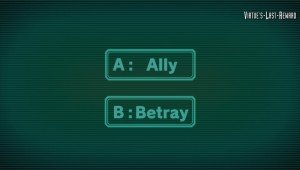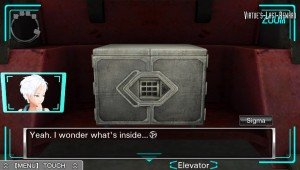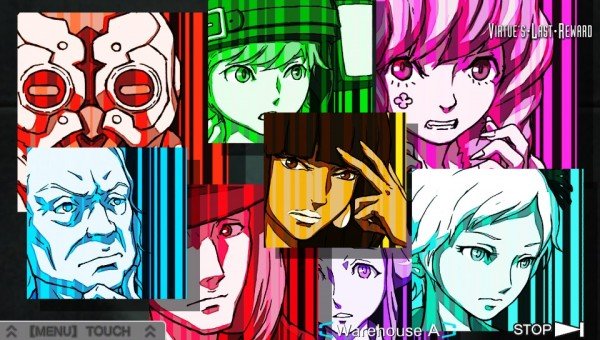Switch to: German
Will you ally … or betray? The choice is your’s in Virtue’s Last Reward for the PlayStation Vita.
Virtue’s Last Reward, the sequel to the cult import-only DS game 999: Nine Hours, Nine Persons, Nine Doors, is a the sort of game you don’t see very often in the West. Visual Novels are a genre that has mostly been confined to Japan, but Virtue’s Last Reward shows that intricate stories such as its own should be enjoyed by all.
Overview

You take the role of Sigma, a young man who wakes up to find himself stuck in a small room, with a mysterious girl being its only other inhabitant. He will soon find that he is far from home and has been forced to play a dangerous game; the Nonary Game. Along with eight others, he must find a way out of the complex he is imprisoned in, all while figuring out who is behind it all.
Gameplay
 Virtue’s Last Reward is split into two distinct part: Novel sections, which is where most of the story is told like most visual novels, and puzzle segments. These puzzle segments are a great addition to the novel sections, since they allow players to do more than just read though lots of text. Each puzzle rooms contains ingenious challenges that will test even the brainiest of gamers.
Virtue’s Last Reward is split into two distinct part: Novel sections, which is where most of the story is told like most visual novels, and puzzle segments. These puzzle segments are a great addition to the novel sections, since they allow players to do more than just read though lots of text. Each puzzle rooms contains ingenious challenges that will test even the brainiest of gamers.
 The aim of each room is to escape through the locked door contained within it. Each one is opened by a key that is found in a safe. Naturally, each safe is also locked, with the password needed being hidden within the room.
The aim of each room is to escape through the locked door contained within it. Each one is opened by a key that is found in a safe. Naturally, each safe is also locked, with the password needed being hidden within the room.
To find the password, and in turn the key, you have to solve a number of different puzzles throughout each room. This is usually done by finding items or hints, then using what you have found to complete different minigames. Some minigames use the Vita’s gyroscope, usually to slide boxed around. Thankfully you are able to use the D-pad for these which ends up being a lot faster.
While each safe contains a key along with story related items, there is also another compartment that you can unlock by finding a second password. This usually requires you to complete harder puzzles without hints from the game. These extra puzzles allow you to unlock files, which flesh out the story further. With the reward for completing each room being more of the game’s amazing story, you will want to persevere even when some of the later puzzles feel like you can’t complete them.
Story
 The game’s story mainly hinges on the prisoner’s dilemma, where betraying someone who trusts you is more beneficial than mutual cooperation. This takes its form in the game as the Ambidex rooms. To escape, the nine participants of the Nonary Game are required to collect nine points. To do so, they are grouped together and made to vote against each other in the aforementioned Ambidex room. There they can make one of two choices: Ally or betray. If both parties choose ally, then they both get two points. However, if one chooses betray, then the betrayer gets three points and the betrayed loses two. These points are recorded on the bracelets that each participant is wearing. These bracelets also show the groups for each found of the Nonary Game. The bracelets also have another feature that is a lot more sinister. If a player has zero points or refuses to follow the rules, they are injected with a deadly substance and killed. This causes some players to betray others to make sure that they survive, which adds another element to the story. The choices that you make during each vote will determine how the story pans out, and which of the 25 endings you will get.
The game’s story mainly hinges on the prisoner’s dilemma, where betraying someone who trusts you is more beneficial than mutual cooperation. This takes its form in the game as the Ambidex rooms. To escape, the nine participants of the Nonary Game are required to collect nine points. To do so, they are grouped together and made to vote against each other in the aforementioned Ambidex room. There they can make one of two choices: Ally or betray. If both parties choose ally, then they both get two points. However, if one chooses betray, then the betrayer gets three points and the betrayed loses two. These points are recorded on the bracelets that each participant is wearing. These bracelets also show the groups for each found of the Nonary Game. The bracelets also have another feature that is a lot more sinister. If a player has zero points or refuses to follow the rules, they are injected with a deadly substance and killed. This causes some players to betray others to make sure that they survive, which adds another element to the story. The choices that you make during each vote will determine how the story pans out, and which of the 25 endings you will get.
 Luckily, each choice you make is not permanent, with the game allowing you to go back to different points in the story to make different decisions. This creates a branching story that can sometimes feel confusing until you’ve made your way through each branch of the story and pieced everything together. Also, as you go further into the story, Sigma will start to remember things that happened in other timelines which adds another interesting element to the story. Each branch that you follow all adds up to create a story that, as a whole, is unique and refreshing in an industry filled will with FPSs and forced multiplayer features.
Luckily, each choice you make is not permanent, with the game allowing you to go back to different points in the story to make different decisions. This creates a branching story that can sometimes feel confusing until you’ve made your way through each branch of the story and pieced everything together. Also, as you go further into the story, Sigma will start to remember things that happened in other timelines which adds another interesting element to the story. Each branch that you follow all adds up to create a story that, as a whole, is unique and refreshing in an industry filled will with FPSs and forced multiplayer features.
Improving on Greatness
 Thankfully, Virtue’s Last Reward does not have one of the main problems that its predecessor had: Repetition. This is mainly avoided thanks to the fact that you can easily make different choices in the game instead of having to replay everything before that choice. The text skip option has thankfully been sped up as well, which allows you to quickly move through dialogue you have read before, without the worry of missing anything new.
Thankfully, Virtue’s Last Reward does not have one of the main problems that its predecessor had: Repetition. This is mainly avoided thanks to the fact that you can easily make different choices in the game instead of having to replay everything before that choice. The text skip option has thankfully been sped up as well, which allows you to quickly move through dialogue you have read before, without the worry of missing anything new.
Negatives
While Virtue’s Last Reward’s story and gameplay are refreshing, there are some problems which stop the game from reaching even greater heights. One of the most notable is the omission of English voiceovers in the PAL version of the game. While this is understandable (licencing two sets of voiceovers would be expensive), it still feels like we’re missing out, especially with a game that is comprised of mostly dialogue. Thankfully, the localisation is top notch and helps to convey the characteristics and mannerisms of each character, but the lack of English voices is still a feature that will be missed.

Another disappointing part of Virtue’s Last Reward is the graphics. While the characters models look decent, they don’t look as nice as the 2D character portraits from the previous game. The 3D does allow for some smoother animations though, and 2D artwork is still used occasionally. Most of the environments also look pretty samey and bland, with only a few of them being visually interested. While this doesn’t matter too much since you’ll usually be focussed on the current story or puzzles, it would have been nice if there was more variety between areas.
 From a gameplay standpoint, the touchscreen controls can occasionally feel unwieldy, with the cursor not selecting what you want it too. Writing using the touchscreen can also be a pain, which is an area that the 3DS has the advantage over the Vita. There are also button controls that can be used, but the weird delay between when you move the analogue stick and when the cursor moves renders this nearly pointless.
From a gameplay standpoint, the touchscreen controls can occasionally feel unwieldy, with the cursor not selecting what you want it too. Writing using the touchscreen can also be a pain, which is an area that the 3DS has the advantage over the Vita. There are also button controls that can be used, but the weird delay between when you move the analogue stick and when the cursor moves renders this nearly pointless.
 While none of these detract from the overall experience too much, there is one thing that could cause players to be annoyed: Crashes. At two different parts we’ve had freezes. While we didn’t lose much progress thanks to the fact that we saved not long before them, it is still a major annoyance and one that will hopefully be patched soon. We’ve also heard reports that the Nintendo 3DS version has a more serious issue with bugs, where gamers’ saves have been corrupted, erasing large chunks of gameplay.
While none of these detract from the overall experience too much, there is one thing that could cause players to be annoyed: Crashes. At two different parts we’ve had freezes. While we didn’t lose much progress thanks to the fact that we saved not long before them, it is still a major annoyance and one that will hopefully be patched soon. We’ve also heard reports that the Nintendo 3DS version has a more serious issue with bugs, where gamers’ saves have been corrupted, erasing large chunks of gameplay.
Conclusion
With challenging puzzles and a gripping story, Virtue’s Last Reward is a game we recommend that any Vita or 3DS owners should buy. The game is surprisingly lengthy, with it taking around 30 hours to complete everything, and the ending is mind-blowing. Best of all, you don’t need to have played 999 to understand everything, with most of the important events of the previous games being explained to you throughout the story. This is definitely a game not to be missed, and I for one can’t wait for the next game to be released.
it/olp
We captured all screenshots from our PS Vita review version.
 Virtue’s Last Reward
Virtue’s Last Reward
Genre: Visual Novel
System: PSVita, 3DS
Version tested: PSVita
Price: 29 GBP /40 US-Dollar / 28 Euro (Retail: UK/US/DE – similiar prices in PSN and eShop)
Developer: Chunsoft
Publisher: Rising Star Games





